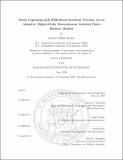| dc.contributor.author | Barter, Garrett Ehud | |
| dc.date.accessioned | 2010-08-27T20:04:52Z | |
| dc.date.available | 2010-08-27T20:04:52Z | |
| dc.date.issued | 2008-06 | |
| dc.identifier.uri | http://hdl.handle.net/1721.1/57606 | |
| dc.description.abstract | The accurate simulation of supersonic and hypersonic flows is well suited to higher-order (p > 1), adaptive computational fluid dynamics (CFD). Since these cases involve flow velocities greater than the speed of sound, an appropriate shock capturing for higher-order, adaptive methods is necessary.
Artificial viscosity can be combined with a higher-order discontinuous Galerkin finite element discretization to resolve a shock layer within a single cell. However, when a non-smooth artificial viscosity model is employed with an otherwise higher-order approximation, element-to-element variations induce oscillations in state gradients and pollute the downstream flow. To alleviate these difficulties, this work proposes a new, higher-order, state-based artificial viscosity with an associated governing partial differential equation (PDE).In the governing PDE, the shock sensor acts as a forcing term, driving the artificial viscosity to a non-zero value where it is necessary. The decay rate of the higher-order solution modes and edge-based jumps are both shown to be reliable shock indicators. This new approach leads to a smooth, higher-order representation of the artificial viscosity that evolves in time with the solution. For applications involving the Navier-Stokes equations, an artificial dissipation operator that preserves total enthalpy is introduced. The combination of higher-order, PDE-based artificial viscosity and enthalpy-preserving dissipation operator is shown to overcome the disadvantages of the non-smooth artificial viscosity.
The PDE-based artificial viscosity can be used in conjunction with an automated grid adaptation framework that minimizes the error of an output functional. Higher-order solutions are shown to reach strict engineering tolerances with fewer degrees of freedom. The benefit in computational efficiency for higher-order solutions is less dramatic in the vicinity of the shock where errors scale with O(h/p). This includes the near-field pressure signals necessary for sonic boom prediction. When applied to heat transfer prediction on unstructured meshes in hypersonic flows, the PDE-based artificial viscosity is less susceptible to errors introduced by poor shock-grid alignment. Surface heating can also drive the output-based grid adaptation framework to arrive at the same heat transfer distribution as a well-designed structured mesh. | en_US |
| dc.description.sponsorship | This work was made possible by the following sources,
• National Defense Science and Engineering Graduate Fellowship
• U. S. Air Force Research Laboratory (USAF-3306-03-SC-0001)
• The Boeing Company
• National Aeronautics and Space Administration (Co-op Agreement NNX07AC70A) | en_US |
| dc.language.iso | en_US | en |
| dc.publisher | Aerospace Computational Design Laboratory, Dept. of Aeronautics & Astronautics, Massachusetts Institute of Technology | en |
| dc.relation.ispartofseries | ACDL Technical Reports;ACDL TR-08-2 | |
| dc.title | Shock Capturing with PDE-Based Artificial Viscosity for an Adaptive, Higher-Order Discontinuous Galerkin Finite Element Method | en |
| dc.type | Technical Report | en |
